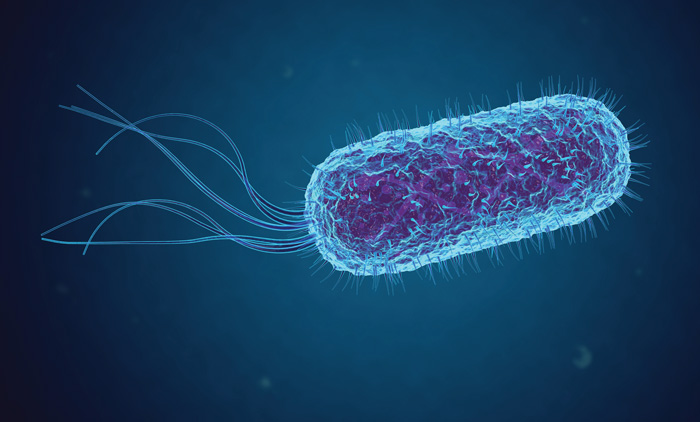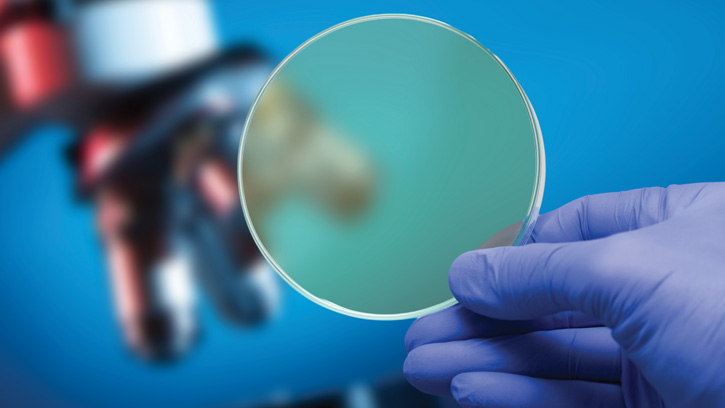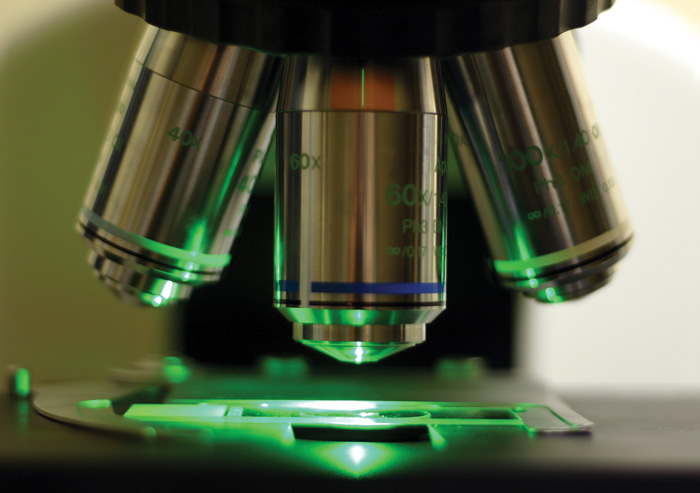Viable but Nonculturable Bacteria Can Threaten Food Safety
FOOD SAFETY AND QUALITY
One of the first Chinese scientists to visit the United States after the Cultural Revolution, professor Huai-Shu Xu (1936–2001) carried out marine microbiology research during his visit to professor Rita Colwell’s laboratory at the University of Maryland (Oliver 2016). In 1982, Xu, Colwell, and colleagues demonstrated that bacterial cells that were typically culturable on laboratory media lose their ability to grow after incubation in stressful environments, yet maintain viability (Xu et al. 1982). This established for the first time that a population of culturable cells could enter a temporary state of existence that prevents growth on nutrient-rich laboratory media. Although scientific opinion on Xu and Colwell’s findings was divided for many years to come, the phenomenon is now widely acknowledged as a significant and distinct survival strategy by several microorganisms and recognized as the viable but not culturable (VBNC) state.
Since the groundbreaking study in Colwell’s lab, which focused on Escherichia coli, an indicator organism for water quality, and Vibrio cholerae, a dangerous human pathogen, many other researchers have documented the presence of the VBNC state in a wide-ranging group of microorganisms. More than 100 species of microorganisms have been reported to enter the VBNC state (Dong et al. 2019). The list includes many foodborne and waterborne pathogens: Campylobacter jejuni, E. coli, Listeria monocytogenes, Salmonella spp., Shigella spp., Staphylococcus aureus, and Vibrio spp. In addition to pathogenic organisms, spoilage and functional microorganisms are also included in the list: Acetobacter spp., Lactobacillus spp., Bifidobacterium spp., Oenococcus oeni, Saccharomyces cerevisiae, and non-Saccharomyces yeasts (Dong et al. 2019). Today, microbiologists continue to study the VBNC state in several micro-organisms and the role of diverse environmental stresses.
Foodborne pathogenic bacteria in the VBNC state are considered a significant threat to public health and food safety because they cannot be detected by conventional, culture-based food and water testing methods. It has been suggested that the VBNC microbial state accounts for the fact that for 80% of foodborne illnesses, linkage to a causative foodborne pathogen remains unknown (Nicolo et al. 2011, Zhao et al. 2017). Awareness of the VBNC phenomenon, better understanding of the mechanisms that influence it, and accurate identification of pathogens in this state are very important to assuring microbial food safety.
VBNC Bacteria—Induction and Characteristics
Microbial cells in the VBNC state display very low, albeit detectable, metabolic activity as compared with their actively growing counterparts. VBNC cells maintain intact cell membranes and continue expressing genes at low but detectable levels. When transferred to solid laboratory media, they do not form colonies (Ayrapetyan et al. 2018, Schottroff et al. 2018). Cells in the VBNC state go through morphological changes, such as shifts from arc shapes to spherical and rod shapes. These morphological changes have been linked to structural and compositional changes in their cell walls and cell membranes, allowing acquisition of higher resistance to environmental stresses than before. These stresses include chemical stresses (high or low salt concentrations, heavy metal toxicity, exposure to ethanol and chlorine), physical stresses (homogenization, heat, ultrasound), and exposure to antibiotics (Dong et al. 2019). Other stressful conditions that can induce the VBNC state include starvation, lack of oxygen, non-optimal temperatures, and pH values. In marine environments, the VBNC state is most often induced by nutrient limitation, and thus it might appear irrelevant to food environments, which tend to be nutrient-rich. Nonetheless, the VBNC state has been shown to be induced in food environments by many stressors, including not only changing NaCl concentrations, but also presence of hypochlorite, and changes in temperature (Dong et al. 2019, Zhao et al. 2017).
Notably, some pathogenic microorganisms in the VBNC state may retain their virulence or regain virulence after exiting from the VBNC state. For example, VBNC cells of Escherichia coli O157:H7 were shown to continue to produce virulence factors (Dinu and Bach 2011). The retention of virulence in VBNC C. jejuni and VBNC L. monocytogenes were shown through human intestinal epithelial cell invasion and Caenorhabditis elegans life span reduction, respectively (Chaisowwong et al. 2012, Highmore et al. 2018).
Resuscitation
VBNC cells are able to leave that state when environmental conditions become satisfactory. They can be resuscitated within a period of time called the “resuscitation window.” This window depends on many factors, including the species and age of the microorganism, VBNC induction conditions, and resuscitation conditions. Although research has established methods to induce resuscitation, comprehensive mechanisms for resuscitation have yet to be proposed. Resuscitation of VBNC cells is demonstrated by an increase in culturability accompanied by an increase in population density. A reversal of the VBNC-inducing stress has been shown to be adequate to resuscitate a VBNC population in several species.
Temperature shifts or steady return of nutrients have also been shown to induce culturability. The addition of exogenous antioxidants such as catalase, superoxide dismutase, and sodium pyruvate to laboratory media have been shown to restore culturability in certain microorganisms, such as E. coli. Nevertheless, species-specific requirements exist for resuscitation. Some VBNC cells have been shown to resuscitate with biological stimuli. For example, C. jejuni requires incubation in embryonated chicken eggs. Additionally, there are microorganisms that are known to enter the VBNC state while their resuscitation conditions are largely unknown (Dong et al. 2019).
Significance for Food Safety
Foods are ecosystems—they are comprised of the environment and the microorganisms that live in the environment. Foods have intrinsic factors (i.e., pH, water activity, and nutrients) and extrinsic factors (i.e., temperature, oxygen and other gasses, and the presence of other microorganisms) that affect microbial growth. Each of these factors may be employed alone or in combination to preserve foods (Matthews et al. 2017). However, these same factors and preservation conditions may induce the VBNC state. The VBNC cells that escape detection may resuscitate prior to consumption of the food. Therefore, the VBNC state of foodborne pathogens is a significant threat to food safety.
Chemical antimicrobials—organic acids, parabenzoic acids, salt, nitrites, phosphates, and disinfectants—are used to control microbial growth in foods. Most chemical antimicrobials inhibit microbial growth without killing the microorganism. Research has shown that chemical antimicrobials can induce the VBNC state in foods. Hong et al. (2019) investigated whether citric acid, along with low temperature, can put S. aureus into the VBNC state. S. aureus was confirmed to enter the VBNC state in 18 days after being treated with citric acid solution (pH 4.0) at 4°C. L. monocytogenes entered the VBNC state in the presence of potassium sorbate at pH 4.0 (Cunningham et al. 2009). Khamisse et al. (2012) demonstrated that VBNC cells were present on polyvinyl chloride (PVC) and stainless-steel surfaces after industrial cleaning/disinfection in a beef processing plant cutting room. Masuku et al. (2014) found that VBNC cells were present after treatment of deli slicers with moist heat and a sanitizer. In a recent screening study with 630 surfactant/salt combinations, Robben et al. (2018) reported the induction of the VBNC state in five human pathogens: E. coli, toxin-producing enteropathogenic Escherichia coli, L. monocytogenes, Salmonella enterica serovar Typhimurium, and S. aureus.
Physical methods of preservation—dehydration processes, cool storage, freezing and frozen storage, as well as heat treatments—can inhibit microbial growth, kill microbial cells, or remove (mechanically) them from foods. Physical manipulations of foods have been shown to induce the VBNC state, however. Anvarian et al. (2016) studied the effect of clarification of orange juice by filtration on the viability and physiology of Escherichia coli K-12 and showed that removal of the orange juice cloud fraction had dramatic effects on bacterial viability during storage at a range of temperatures. L. mono-cytogenes in the VBNC state were detected and identified from frozen vegetables (Moreno et al. 2012). E. coli O157:H7 cells on the surface of lettuce and spinach were induced to the VBNC state by low temperature (Dinu and Bach 2011, 2013). Refrigerated, pasteurized grapefruit juice induced the VBNC state in E. coli O157:H7 and Salmonella Typhimurium within 24 hr of incubation (Nicolo et al. 2011). Finally, Gunasekera et al. (2002) reported that in pasteurized milk that had undergone thermal treatment, contaminating bacteria such as E. coli entered the VBNC state but retained viability.
Nonthermal processing methods—high pressure, ozone, ultraviolet light, pulsed electric fields (PEF), oscillating magnetic fields, and ultrasound—are increasingly intricate and advanced, and less disruptive to food quality. Yet, they can induce the VBNC state as does traditional thermal processing. Zhang et al. (2015) found that VBNC E. coli cells can tolerate UV disinfection. Zhao et al. (2013) demonstrated that high pressure CO2 can induce E. coli O157:H7 to the VBNC state. Kramer and Muranyi (2014) studied the effect of PEF on Listeria innocua and E. coli and showed that a considerable proportion of cells entered the VBNC state after the treatment. On a positive note, Saroj et al. (2009) demonstrated that gamma-irradiation resulted in complete killing of Salmonella enterica subsp. enterica serovar Typhimurium without leading to the formation of VBNC cells.
Detection Methods
In the VBNC state, microorganisms cannot grow and develop colonies on conventional nonselective media, but they are alive and able to resuscitate to a culturable state under favorable conditions. Due to their nonculturable status, VBNC cells cannot be detected using conventional detection methods based on microbial growth in/on microbiological media. However, VBNC cells can be detected using conventional and novel detection methods that target their viability.
The direct viable count (DVC), a method based on the microbial response to antibiotics and nutrient uptake, was the first method adopted to detect VBNC cells. Two more effective methods followed—the fluorescence redox probe CTC-DAPI, a method based on metabolic activity, and the LIVE/DEAD Baclight assay, which is based on cytoplasmic membrane integrity. Advances in molecular biology have led to additional methods for detecting VBNC cells. These methods include propidium-monoazide (PMA) qPCR, which only allows for the amplification and quantification of DNA from cells with intact cell membranes, and reverse-transcription quantitative PCR (RT-qPCR), which targets mRNA as a viability marker.
More recently developed novel detection methods include phage-mediated detection systems, biosensors, microfluidic-based techniques, D2O-labeled Raman spectroscopy, matrix-assisted-laser desorption ionization time-of-flight mass spectrometry (MALDI-TOF-MS), liquid chromatography-mass spectrometry, autoradiography, ATP generation, and DNase I protection assay (Dong et al. 2019).
Future Directions
An estimated 99% of bacteria in the environment may be nonculturable. VBNC cells are found in many diverse environments, including marine, soil, and the gastrointestinal tract. They are also found in drinking water, water used to clean fresh produce, and processed foods. Coupled with the risks that foodborne and waterborne pathogens pose to public health and food safety, increased awareness of the VBNC state in microorganisms is expected to lead to: 1) reexamination of our reliance on conventional culture methods to detect microorganisms in foods; 2) improvement of existing methods and development of novel methods for detecting VBNC bacteria in foods; and 3) successful eradication of VBNC pathogens via improved and new food processing technologies as well as combinations of technologies. Additionally, the mechanisms of the formation of the VBNC state, resuscitation of VBNC cells, and resuscitation regulation need to be further elucidated.
REFERENCES
Anvarian, A. H. P., M. P. Smith, T. W. Overton. 2016. “The Effects of Orange Juice Clarification on the Physiology of Escherichia coli; Growth-Based and Flow Cytometric Analysis.” Int. J. Food Microbiol. 219: 38–43. https://doi.org/10.1016/j.ijfoodmicro.2015.11.016.
Ayrapetyan, M., T. Williams, J. D. Oliver. 2018. “Relationship between the Viable but Nonculturable State and Antibiotic Persister Cells.” J. Bacteriol. 200(20): e00249-18. doi: 10.1128/JB.00249-18.
Chaisowwong, W., A. Kusumoto, M. Hashimoto, et al. 2012. “Physiological Characterization of Campylobacter jejuni Under Cold Stresses Conditions: Its Potential for Public Threat.” J. Vet. Med. Sci. 74: 43– 50. https://doi.org/10.1292/jvms.11-0305.
Cunningham, E., C. O’Byrne, J. D. Oliver. 2009. “Effect of Weak Acids on Listeria monocytogenes Survival: Evidence for a Viable but Nonculturable State in Response to Low pH.” Food Control 20(12): 1141–1144. https://doi.org/10.1016/j.foodcont.2009.03.005.
Dinu, L.-D. and S. Bach. 2011. “Induction of Viable but Nonculturable Escherichia coli O157:H7 in the Phyllosphere of Lettuce: A Food Safety Risk Factor.” App. Environ. Microbiol. 77(23): 8295–8302. doi: 10.1128/AEM.05020-11.
Dinu, L.-D. and S. Bach. 2013. “Detection of Viable but Non-Culturable Escherichia coli O157:H7 from Vegetable Samples Using Quantitative PCR with Propidium Monoazide and Immunological Assays.” Food Control 31(2): 268–273. https://doi.org/10.1016/j.foodcont.2012.10.020.
Dong, K, H. Pan, D. Yang, et al. 2019. “Induction, Detection, Formation, and Resuscitation of Viable but Non-Culturable State Microorganisms.” Compr. Rev. Food Sci. Food Saf. 19: 149–183. https://doi.org/10.1111/1541-4337.12513.
Gunasekera, T. S., A. Sørensen, P. V. Attfield, et al. 2002. “Inducible Gene Expression by Nonculturable Bacteria in Milk After Pasteurization.” Appl. Environ. Microbiol. 68(4): 1988–1993. doi: 10.1128/aem.68.4.1988-1993.
Highmore, C. J., J. C. Warner, S. D. Rothwell, et al. 2018. Viable-but-Nonculturable Listeria monocytogenes and Salmonella enterica serovar Thompson Induced by Chlorine Stress Remain Infectious. MBio 9, e00540–18. https://doi.org/10.1128/mBio.00540-18.
Hong, B., F. Zhao, M. Li, et al. 2019. “Citric Acid Can Force Staphylococcus aureus into Viable but Nonculturable State and its Characteristics.” Int. J. Food Microbiol. 305: 108254. https://doi.org/10.1016/j.ijfoodmicro.2019.108254.
Khamisse E., O. Firmesse, S. Christieans, et al. 2012. “Impact of Cleaning and Disinfection on the Non-Culturable and Culturable Bacterial Loads of Food-Contact Surfaces at a Beef Processing Plant.” Int. J. Food Microbiol. 158(2): 163–168. doi: 10.1016/j.ijfoodmicro.2012.07.014.
Kramer, B. and P. Muranyi. 2014. “Effect of Pulsed Light on Structural and Physiological Properties of Listeria innocua and Escherichia coli. J. Appl. Microbiol. 116: 596–611. https://doi.org/10.1111/jam.12394.
Masuku, S. M., D. Babu, E. M. Martin, et al. 2014. “Lethality of Moist Heat and Silver Dihydrogen Citrate Sanitizer Combinations on Listeria spp. Adhered to Components of a Deli Meat Slicer.” Food Control 44: 227–232. https://doi.org/10.1016/j.foodcont.2014.03.030.
Matthews, K. R., K. E. Kniel, T. J. Montville. 2017. Food Microbiology: An Introduction. Washington, DC: ASM Press.
Moreno, Y., J. Sánchez-Contreras, R. M. Montes, et al. 2012. “Detection and Enumeration of Viable Listeria monocytogenes Cells from Ready-to-Eat and Processed Vegetable Foods by Culture and DVC-FISH. Food Control 27(2): 374–379. https://doi.org/10.1016/j.foodcont.2012.04.017.
Nicolò, M. S., A. Gioffrè, S. Carnazza, et al. 2011. “Viable but Nonculturable State of Foodborne Pathogens in Grapefruit Juice: A Study of Laboratory.” Foodborne Path. Dis. 8(1): 11–17.
Oliver, J. D. 2016. “The Viable but Nonculturable State for Bacteria: Status Update.” Microbe 11(4): 159–164.
Robben, C., S. Fister, A. K. Witte, et al. 2018. “Induction of the Viable but Non-Culturable State in Bacterial Pathogens by Household Cleaners and Inorganic Salts. Sci. Rep. 8: 15132. https://doi.org/10.1038/s41598-018-33595-5.
Schottroff, F., A. Frohling, M. Zunabovic-Pichler, et al. 2018. “Sublethal Injury and Viable but Non-Culturable (VBNC) State in Microorganisms During Preservation of Food and Biological Materials by Non-Thermal Processes. Front. Microbiol. 9: 2773. https://doi.org/10.3389/fmicb.2018.02773.
Saroj, S., R. Shashidhar, J. Bandekar. 2009. “Gamma Radiation Used as Hygienization Technique for Foods Does Not Induce Viable but Non-Culturable State (VBNC) in Salmonella enterica subsp. enterica serovar Typhimurium.” Curr. Microbio. 59: 420–424. https://doi.org/10.1007/s00284-009-9454-3.
Xu, H. S., N. Roberts, F. L. Singleton, et al. 1982. “Survival and Viability of Nonculturable Escherichia coli and Vibrio cholerae in the Estuarine and Marine Environment.” Microbiol. Ecol. 8: 313–323. https://doi.org/10.1007/BF02010671.
Zhang, S., C. Ye, H. Lin, et al. 2015. “UV Disinfection Induces a VBNC State in Escherichia coli and Pseudomonas aeruginosa.” Env. Sci. Technol. 49(3): 1721–1728. doi: 10.1021/es505211e.
Zhao, F., X. Bi, Y. Hao, et al. 2013. “Induction of Viable but Nonculturable Escherichia coli O157:H7 by High Pressure CO2 and Its Characteristics.” PLOS ONE 8(4): e62388. https://doi.org/10.1371/journal.pone.0062388.
Zhao, X., J. Zhong, C. Wei, et al. 2017. “Current Perspectives on Viable but Non-Culturable State in Foodborne Pathogens. Front. Microbiol. 8: 580. https://doi.org/10.3389/fmicb.2017.00580.








